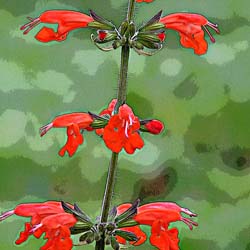Sacred Sage: Salvia coccinea -- An American Subtropical Treasure

Although it probably originated somewhere in Mexico, Tropical Sage (Salvia coccinea) existed in the American Southeast prior to European exploration of the New World. Having naturalized in the time before Christopher Columbus arrived, it is considered an American native plant.
One mystery about the vigorous, bright-blossomed S. coccinea concerns who first collected the plant for botanical study. However, the scientific name is traced back to a German scholar named Andreas Ernst Etlinger who was a friend of Carl Linnaeus, the father of scientific classification.
Etlinger wrote about S. coccinea in his 1777 doctoral thesis De Salvia dissertatio inauguralis, a document that is notable for being an early botanical monograph about the Salvia genus.
Many Common Names
S. coccinea has a number of common names other than Tropical Sage. They include Blood Sage, Hummingbird Sage, Scarlet Sage and Texas Sage. Each one provides a key detail about the species: First, its tubular flowers are often a deep scarlet or other shade of red that attracts hummingbirds. However, other colors of Tropical Sage exist, including lavender. Second, Texas is home to Tropical Sage along with Alabama, Florida, Georgia, Hawaii, Louisiana, South Carolina and a single county in Ohio. Puerto Rico and the Virgin Islands are other U.S. sites where it has naturalized.
Aside from Mexico, Tropical Sage is native to other parts of Central America and to South America as well. It has naturalized in parts of Europe and Africa, including the island of Madagascar where it grows in the shady Agnalazaha forest. The people of Madagascar call it Romba madinika and use its leaves to treat for parasites.
Medical Research
Tropical Sage isn't edible, but the ASPCA notes that it isn't poisonous for pets roaming in gardens. Yet creating teas or tinctures from this plant probably isn’t a good idea, because there are some reports about it causing gastric disturbance.
Medical researchers have concluded that the phytochemicals of Tropical Sage show potential for fighting illnesses caused by inflammation and oxidative stress. Oxidative stress causes unstable atoms called free radicals to damage cells, such as in cancer and cardiovascular disease.
Fine Nectar Plants
At Flowers by the Sea, we grow Salvias for their beauty and ability to feed our favorite small wildlife -- butterflies, honeybees and hummingbirds. Wild Tropical Sage and its cultivars are excellent for gardens designed to attract pollinators. That's why the Tampa, Florida, Museum of Science and Industry named S. coccinea, its "number-one nectar plant."
Tropical Sage provides an abundant supply of nectar, because it blooms from spring to fall. Its small, green leaves are fuzzy, heart shaped and serrated at the edges. In warm zones, the foliage remains green nearly year round.
We limit our selection of Tropical Sage to the cultivars we consider to be the best, most long blooming and easiest to grow. They are tender perennials in USDA Cold Hardiness Zones 9 to 11 and excellent bedding plants in areas with colder winters.
These are Salvias that appreciate rich soil and average watering based on local rainfall. They do well in full sun to partial shade wherever you need a big splash of color. Try them in patio containers or massed as part of a border. Here are some details about the varieties we grow:
Lady in Red Tropical Sage (Salvia coccinea 'Lady in Red')
- Red flowers
- Green calyxes
- 36 inches tall in bloom, 24 inches wide (not the dwarf variety)
Brenthurst Tropical Sage (Salvia coccinea 'Brenthurst')
- Coral-pink flowers
- Dark green calyxes
- 30 inches tall in bloom, 18 inches wide
Coral Nymph Tropical Sage (Salvia coccinea 'Coral Nymph')
- Peachy pink-to-white flowers
- Reddish-green calyxes
- 12 inches tall and wide
Forest Fire Tropical Sage (Salvia coccinea 'Forest Fire')
- Fire-engine red flowers
- Reddish-black calyxes
- 24 to 36 inches tall, 24 inches wide
Summer Jewel Red Tropical Sage (Salvia coccinea 'Summer Red Jewel')
- Bright red flowers
- Reddish-green bracts
- 24 to 36 inches tall, 24 inches wide
Summer Jewel Pink Tropical Sage (Salvia coccinea 'Summer Pink Jewel')
- Showy bright pink and white flowers
- Green bracts
- 24 to 36 inches tall, 24 inches wide
Summer Jewel White Tropical Sage (Salvia coccinea 'Summer Jewel White')
- Pure white flowers
- Green calyxes
- 24 inches tall in bloom, 18 inches wide)
Questions About Variability
Similar to another species commonly called Scarlet Sage (S. splendens), Tropical Sage is one of those species for which many variations exist. For example, we sell a tall variety of Lady in Red whereas a number of other companies use the same name for dwarf varieties.
If you have questions about the variability of sizes, flower colors or any other matters regarding Tropical Sage or other Salvias, please contact us. We're always willing to share information.

 Salvia coccinea 'Vermilion'
Salvia coccinea 'Vermilion'  Salvia coccinea 'Summer Jewel White'
Salvia coccinea 'Summer Jewel White'  Salvia coccinea 'Lady in Red'
Salvia coccinea 'Lady in Red'  Salvia coccinea 'Snow Nymph'
Salvia coccinea 'Snow Nymph'  Salvia coccinea 'Brenthurst'
Salvia coccinea 'Brenthurst'  Salvia coccinea 'Summer Jewel Pink'
Salvia coccinea 'Summer Jewel Pink'  Salvia coccinea 'Summer Jewel Red'
Salvia coccinea 'Summer Jewel Red'  Salvia coccinea 'Forest Fire'
Salvia coccinea 'Forest Fire'  Salvia coccinea 'Coral Nymph'
Salvia coccinea 'Coral Nymph'
Comments
There are no comments yet.